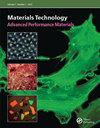离子液体作为6061铝合金缓蚀剂的效果——(电化学和量子化学方法)
IF 3.7
4区 材料科学
Q3 MATERIALS SCIENCE, MULTIDISCIPLINARY
引用次数: 0
摘要
本文章由计算机程序翻译,如有差异,请以英文原文为准。
Effect of ionic liquid as corrosion inhibitor for 6061 aluminium alloy-(electrochemical and quantum chemical approaches)
ABSTRACT Ionic liquid 1,3-dimethylimidazolium dimethyl phosphate (DIDP) is used as a possible green inhibitor for the corrosion control of 6061 aluminium alloy in 0.25 mol/L HCl is described in the study. Study involved electrochemical methods carried out at various temperatures by changing the concentrations of DIDP. Kinetic and thermodynamic parameters were determined using the Arrhenius rate law and transition state equations, respectively. Physisorption of the inhibitor takes place and the adsorption follows Freundlich isotherm. Surface morphology was studied by scanning electron microscopy (SEM), atomic force microscopy (AFM), and energy-dispersive X-ray analysis (EDAX) techniques. Quantum chemical studies were done by the density functional theory (DFT). The maximum inhibition efficiency of DIDP on 6061 aluminium alloy was about 78% for the concentration of 1000 ppm at 303 K. The mechanistic aspects of DIDP adsorption onto the metal surface were supported by quantum chemical studies. HOMO and LUMO of the optimized structure and quantum chemical descriptors confirmed the adsorption of the inhibitor on the metal surface. Mulliken charge population was used to identify the DIDP molecule’s high electron density region, and Fukui indices confirmed the interaction between metal and inhibitor. GRAPHICAL ABSTRACT
求助全文
通过发布文献求助,成功后即可免费获取论文全文。
去求助
来源期刊

Materials Technology
工程技术-材料科学:综合
CiteScore
6.00
自引率
9.70%
发文量
105
审稿时长
8.7 months
期刊介绍:
Materials Technology: Advanced Performance Materials provides an international medium for the communication of progress in the field of functional materials (advanced materials in which composition, structure and surface are functionalised to confer specific, applications-oriented properties). The focus is on materials for biomedical, electronic, photonic and energy applications. Contributions should address the physical, chemical, or engineering sciences that underpin the design and application of these materials. The scientific and engineering aspects may include processing and structural characterisation from the micro- to nanoscale to achieve specific functionality.
 求助内容:
求助内容: 应助结果提醒方式:
应助结果提醒方式:


